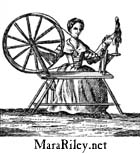| "Poor people didn't wear stays", "all women always wore stays," and "Stays were never worn uncovered." | |
|
As with most sweeping statements, neither of the above statements is true. Poor women DID frequently wear stays; not wearing them was generally considered a sign of loose morals, and was considered so important that poorhouses in England provided them to the women in their care. Stays were often available on the used clothing market, or could be made at home, so they weren't necesarily out of the financial reach of poor women; and many period depictions show lower-class women wearing stays (milkmaids, fishwives, etc.). On the other hand, there are also period depictions and descriptions of women who aren't wearing stays. Who were they? Well, to name a few examples, there's the whore's servant in "A Harlot's Progress", who wears a bedgown without stays underneath; the "Jersey Nanny" (presumably a nursemaid, but nothing more is known about her", who wears what appears to be a bedgown pinned shut; the Scots-Irish young women described in Dodderidge's journal of his travels on the frontier, who wore nothing but a shift pinned close to reveal their figures. These women would have been considered 'slatterns', slovenly or unfashionable people outside the mainstream of society. Also, women who were in the privacy of their own home (due to post-pregnancy confinement or illness) could wear a lightly boned or unboned garment called 'jumps', or a quilted waistcoat, which provided moderate support and modesty. They would not have worn these items in public, say, to the market or church. So, choose an option that is appropriate to your impression. If you are portraying a slattern (and I have a few friends who do, and have a good deal of fun with that impression), then that's fine. But if you want to portray a 'proper' woman, you really do need to wear stays. I think many women resist wearing stays because they think that stays will be uncomfortable -- they associate them with the scene in "Gone With the Wind" where Scarlett is being laced into her corset. Nothing could be further from the truth. A good-fitting corset should be snug enough not to move around much on the body, but you should be able to breathe while wearing it (you may need to loosen your stays a little if you plan on dancing vigorously, of course). And stays for women who expected to work in them were cut differently from those worn by upper-class women; the armscyes were bigger, and allowed for more arm movement. Half-boned stays are fine, by the way. There seems to be an attitude in some reenacting circles that fully-boned stays are 'better' than half-boned stays, but both styles were period, as well as stays that were fully-boned in front (for better support) and half-boned in back. As to where it's appropriate to wear your stays uncovered - there are period depictions and descriptions of women wearing stays in their own homes. For instance, women are shown doing laundry, picking apples, or serving tea to the master of the house while wearing their stays. In some of the street scenes by Pyne and others, a woman is shown in the street bringing a chair to a peddler who is going to re-cane the seats. So, if you are working, your stays may be uncovered. (They don't have to be, of course; there are also pictures of women working while wearing their gowns or jackets.) However, if you are 'in public' in the sense of going to market, going to visit neighbors, or going to church or a public meeting, you really should be wearing a gown or jacket or some other covering over your stays. A generation ago, it was considered rude for men to appear in public without a jacket over their shirts. If you saw a man in his shirtsleeves, it was in a working context. Now, anything goes. So we've lost a lot of the social context needed to understand the mindset of what clothing was worn in what circumstances. |
|
|
|
|
|
|
|
